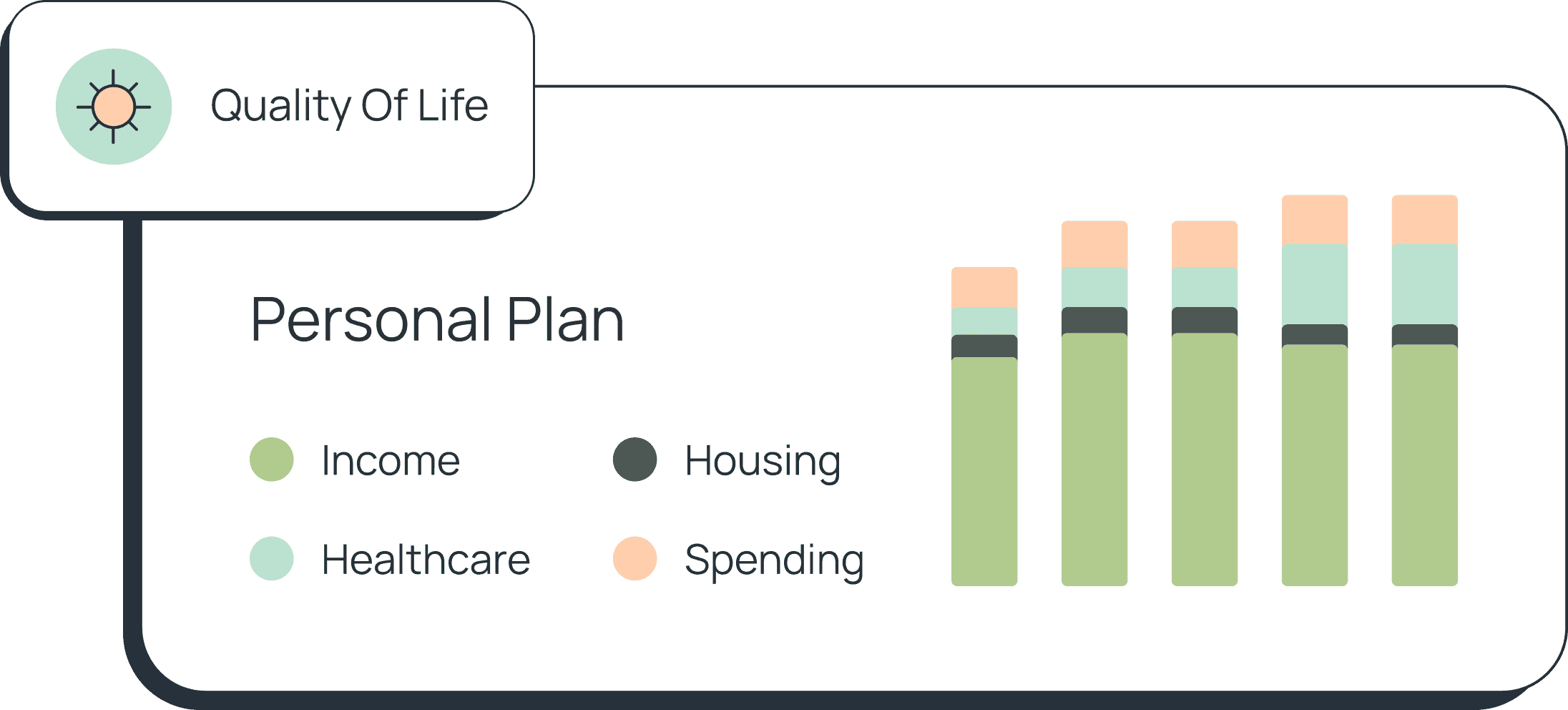Income
No question about it: $800,000 is a lot of money. Congratulations on all the hard work it took to get here—after so many years of financial planning and saving, it’s no wonder that you’re ready to start planning for retirement. $800,000 is enough to retire on in many parts of the US, but your savings can go a lot further—and allow you to live more luxuriously—in less costly locations.

R. Tyler End, CFP®
•
Published November 8th, 2024
•
Updated February 4th, 2025
Table of Contents
Key Takeaways
$800,000 is a notable, sizable savings, but it likely won’t be enough for you to retire in luxury in California or Hawaii
Consider retiring to midwest or southern cities such as Chicago, Atlanta, or St. Louis to get the most bang for your buck
By waiting to take Social Security later, wisely investing your funds, and reducing your cost of living, you should be able to make $800,000 a viable retirement savings.
No question about it: $800,000 is a lot of money. Congratulations on all the hard work it took to get here—after so many years of financial planning and saving, it’s no wonder that you’re ready to start planning for retirement. $800,000 is enough to retire on in many parts of the US, but your savings can go a lot further—and allow you to live more luxuriously—in less costly locations. Let’s take a look at all the factors to consider before you turn in your retirement notice.
How Earnings and Inflation are Impacting Retirement for Many Americans
In June of 2022, inflation reached a staggering high of 9.1%—the highest jump seen since the 1980s. Although the rate has since dropped, it remains above the 2% average that indicates price stability. As of January 2025, the rate sits at 3%, meaning Americans' paychecks aren’t stretching as far for common consumer items. In short, it’s more expensive to pay for groceries, gas, and other necessities.
These are some of the categories hit hardest in January 2025, with percentages indicating year-over-year price changes:
- Eggs: 53%
- Motor vehicle insurance: 11.8%
- College textbooks: 10.7%
- Other condiments: 10.3%
- Uncooked beef roasts: 7.5%
- Instant coffee: 7.1%
- Bacon: 6%
- Gas service: 4.9%
Source: CNBC
Given the overall higher cost of goods, many people are cutting back on retirement savings. The New York Times reported an increase in the number of hardship withdrawals from 401(k) accounts in 2023. Ultimately, this has delayed retirement for many, with some saying it’s entirely out of reach.
Even if you haven’t needed to withdraw or pause your savings, inflation has likely impacted your retirement saving vehicles—different accounts weather inflation in different ways.
Social Security
While Social Security benefits are evaluated every year to be adjusted against the cost-of-living, these adjustments have historically been seen as inadequate. The Senior Citizens League reported that seniors lost one-third of their buying power between 2000 and 2021. The League also noted that the cost of goods and services increased by 99.3% between 2000 and 2020, while the Social Security COLA adjustments only rose by 53%.
Note, also, that by waiting until you are older to take your Social Security benefits, the more you will receive each month. When you take the earliest Social Security option, you dramatically reduce your monthly payout for the remainder of your life. Crunch the numbers to determine the difference between retiring at 60 with $800k or waiting until you’re 65, 66, 67, or later.
Pensions
Pension plans are typically tied to several of your last years of salary rates. If a period of high inflation hits during the last few years of your working years, it’s possible that your final benefit amount may come in lower as the calculation was made on pre-inflation salary. If high inflation hits after you retire, your payouts will be based on the salary you earned previous to inflation. It’s also important to note that private pensions often do not adjust for inflation at all—only state or local government plans.
401(k) and IRA Accounts
Investments and dividends don’t adjust for inflation, so the money invested in your 401(k) or IRA can be negatively impacted during periods of high inflation. For example: if you’re getting a return of 10% on your 401(k), but inflation hits 8%, you’ll only see a 2% gain on your investment. If you’re getting a return below 8%, your net gain will be negative. The typical target for a 401(k) is a 5 to 8% return (IRAs are typically between 7 and 10%), so when inflation rises above this, your 401(k) could take a hit. That said, 401(k) accounts are still good investment vehicles as they see a higher interest rate than many other types of accounts.
Mitigating Inflation’s Impact on Your Retirement Savings
- Diversify: Avoid holding only stocks or bonds—diversify your portfolio. Speak with a Certified Financial Planner to review your investments.
- Adjust spending: Assume some level of inflation and adjust your retirement budget accordingly. For example, if you plan for $50,000 in annual retirement income, a 5% inflation rate would require a $2,500 increase in the second year.
- Pay off debts: Eliminate adjustable-rate mortgages and credit card debt before retiring to avoid increased costs during inflationary periods.
- Consult a planner: Work with a Certified Financial Planner to strategize for your future goals and milestones.
Is $800k Enough to Retire on in 2024?
While $800,000 is a significant amount, it may or may not be enough for your retirement, depending on your lifestyle, location, and debts. It’s essential to invest your savings wisely. Consult with a Certified Financial Planner to ensure your investments align with your financial goals and risk tolerance.
First and foremost, you should make sure your money is wisely invested so you can reap high returns from it. Talk to a Certified Financial Planner to invest your savings in a way that matches your financial goals, timeline, and risk tolerance.
If your average annual return is between 10–12%, you could have $80,000 to $96,000 in annual income. However, in a slow year with an 8% return, you’d have only $64,000, potentially forcing you to dip into your principal.
Major Costs to Consider During Retirement
- Housing: If you don’t own your home, expect higher rental costs. Home maintenance costs may also rise as you age.
- Healthcare: The average 65-year-old couple spends about $12,000 on healthcare in their first retirement year, and costs may increase depending on your health needs.
- Transportation: Rising gas prices or alternative transportation options like taxis and car-sharing services should be factored into your budget.
It’s also extremely important to remember that inflation, while usually jumping about 1–2% per year, can jump to higher rates and reduce your spending power. Note that there are many places in the world that are significantly less expensive than the United States, and many retirees choose to live in these places in order to make their retirement savings stretch. Consider Mexico, South America, and some parts of Asia if you seek a lower cost-of-living—$800,000 can go much farther and allow you to live more luxuriously in these locations.
That said, there are still many places in the US where your $80,000 can allow you to retire comfortably. While it might not allow for a luxurious retirement in Los Angeles, San Francisco, or Miami, it should be plenty to allow you to live on the coast, in smaller cities such as Spokane, San Diego, or Charleston.
A city worth considering, with this amount of savings, is Atlanta, Georgia. Not only does it boast excellent healthcare and other amenities, but the weather is excellent and the cost of living is lower than many other similarly-sized cities.
Overall, $80,000 is enough to give you a wide range of places with different climates and vibes. If you have your heart set on an oceanfront home or want to live lavishly during retirement, try to save more money or wait to retire until you turn 70, when you can get the maximum benefit from your Social Security. Another option is to retire from your full-time job while keeping some part-time work to boost your monthly cash flow.
When weighing where to move for retirement, make sure to research city and state income taxes, and understand which sources of retirement income are taxed in each location. Some states have no income tax at all, while others will tax all of your retirement income—including social security. If you’ve got your heart set on the west coast, know that the state of Washington does not tax income at all, so a retirement savings of $800,000 can go much further there, even if the cost of living is a little higher than interior or southern states.
Factors to Consider When Planning for Retirement
- Cost of Living: Inflation typically increases by 1–2% annually. Calculate your future income needs based on a higher inflation rate to ensure adequate savings.
- Taxes: Each state has its own tax laws. Some states tax Social Security benefits, while others do not. Consider a Roth IRA if you anticipate a higher income bracket during retirement.
- Lifestyle: Decide if you want to maintain your current lifestyle, downsize, or pursue more luxury and travel.
- Health: Your health status may affect how long your retirement savings need to last. Consider supplemental insurance plans for additional coverage.
- Location: Evaluate the tax implications and cost of living in different states or cities. Transportation costs can also be significant, depending on where you live.
- Income Sources: Beyond Social Security, review your rental income, IRAs, or other investments. Some retirees may also choose part-time work to supplement income.
How to Retire on $800K by Age
| Age | Income per year (without interest) | Interest (4%) | Income per year (with interest) |
|---|---|---|---|
| 50 | $29,629 | $1,185 | $30,814 |
| 55 | $36,363 | $1,454 | $37,817 |
| 60 | $47,058 | $1,882 | $48,940 |
| 65 | $66,666 | $2,666 | $69,332 |
| 70 | $114,285 | $4,571 | $118,856 |
Schedule your FREE consultation.

Can you live off monthly interest on $800,000?
If your annual returns are 5%, you would be working with $40,000 per year or $3,333 per month. Returns can always be higher or lower than this, depending on your investments—if you aren’t confident in your current portfolio, make sure to talk to a Certified Financial Planner to come up with a solid strategy. One thing to note: the average cost of a one-bedroom in the US is $1,487. Using our calculation above, that would leave you with $1,846 for your other expenses, some of which might be higher than they were while you were working—medical care for instance. One option, to boost your income, is to wait to collect your Social Security benefits—if you wait until age 70 to retire, you will receive the maximum benefit.
Can a couple retire on $800,000?
Having to stretch $800,000 between two people will definitely require more financial planning and strategy, but it is possible, depending on where you live and other factors. If you are both in excellent health, that means you may live longer, so the funds would need to stretch for additional years. If you suffer from any kind of medical condition, you’ll need to factor in your healthcare costs. Ideally, you and your partner will find ways together to cut back on spending to make $800,000 work—you might consider moving somewhere with a lower cost of living, downsizing, or continuing to work on a part-time basis. Make sure, also, to calculate how much you will have from your Social Security benefit, as well as the local and state income taxes you will be subjected to.
Can I retire at 50/55/60/65 with $800,000?
Deciding when to retire will require a close look at your current lifestyle, the lifestyle you wish to have during retirement, and your current expenses. The best way to determine whether or not what you have saved is enough is to talk to a Certified Financial Planner; they can review your investments and make suggestions for ways you might be able to cut down on spending, allowing you to retire at the age you wish to.
Share this advice

Tyler is a Certified Financial Planner® and CEO & Co-Founder at Retirable, the retirement peace of mind platform. Tyler has nearly 15 years of experience at leading companies in the wealth management and insurance industries. Before Retirable, Tyler worked as Head of Operations Expansion at PolicyGenius, expanding the company’s reach into new products — turning PolicyGenius into an industry-leading disability and P&C insurance distributor. Before working at PolicyGenius, Tyler worked as Wealth Management Advisor at prominent financial services organizations.
As an advisor, Tyler played an integral role in helping clients define goals, achieve financial independence and retire with peace of mind. Through this work, Tyler has helped hundreds of thousands of people get the financial planning and insurance advice they need to succeed. Since founding Retirable, Tyler’s innovative approach to retirement planning has been featured in publications such as Forbes, Fortune, U.S. News & World Report, and more.
Share this advice

Tyler is a Certified Financial Planner® and CEO & Co-Founder at Retirable, the retirement peace of mind platform. Tyler has nearly 15 years of experience at leading companies in the wealth management and insurance industries. Before Retirable, Tyler worked as Head of Operations Expansion at PolicyGenius, expanding the company’s reach into new products — turning PolicyGenius into an industry-leading disability and P&C insurance distributor. Before working at PolicyGenius, Tyler worked as Wealth Management Advisor at prominent financial services organizations.
As an advisor, Tyler played an integral role in helping clients define goals, achieve financial independence and retire with peace of mind. Through this work, Tyler has helped hundreds of thousands of people get the financial planning and insurance advice they need to succeed. Since founding Retirable, Tyler’s innovative approach to retirement planning has been featured in publications such as Forbes, Fortune, U.S. News & World Report, and more.
Free Retirement Consultation
Still have questions about how to properly plan for retirement? Speak with a licensed fiduciary for free.



